Unit 5 I’m watching TV. (Section B 1a-2c )
文档属性
| 名称 | Unit 5 I’m watching TV. (Section B 1a-2c ) | 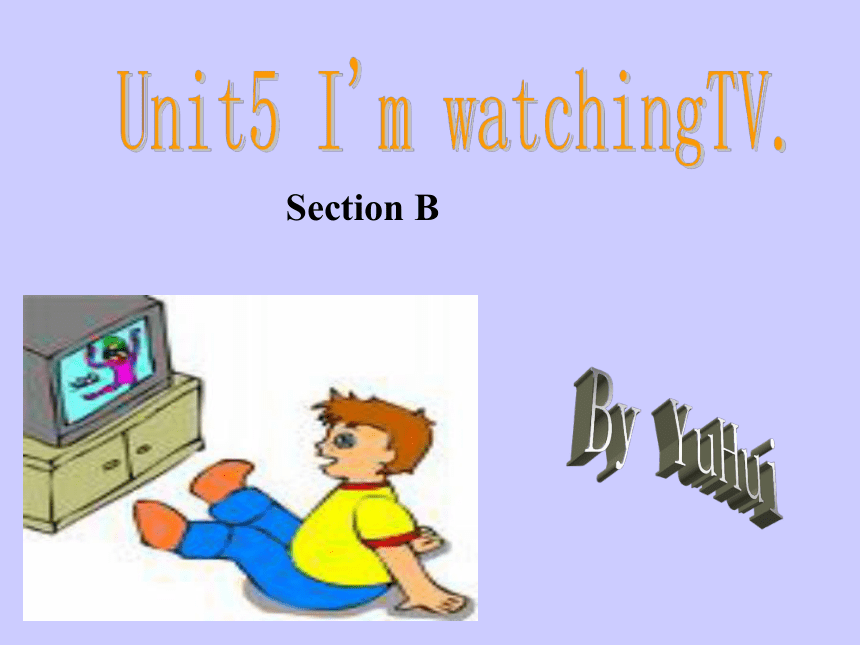 | |
| 格式 | rar | ||
| 文件大小 | 486.2KB | ||
| 资源类型 | 教案 | ||
| 版本资源 | 人教新目标(Go for it)版 | ||
| 科目 | 英语 | ||
| 更新时间 | 2010-12-04 10:56:00 | ||
图片预览

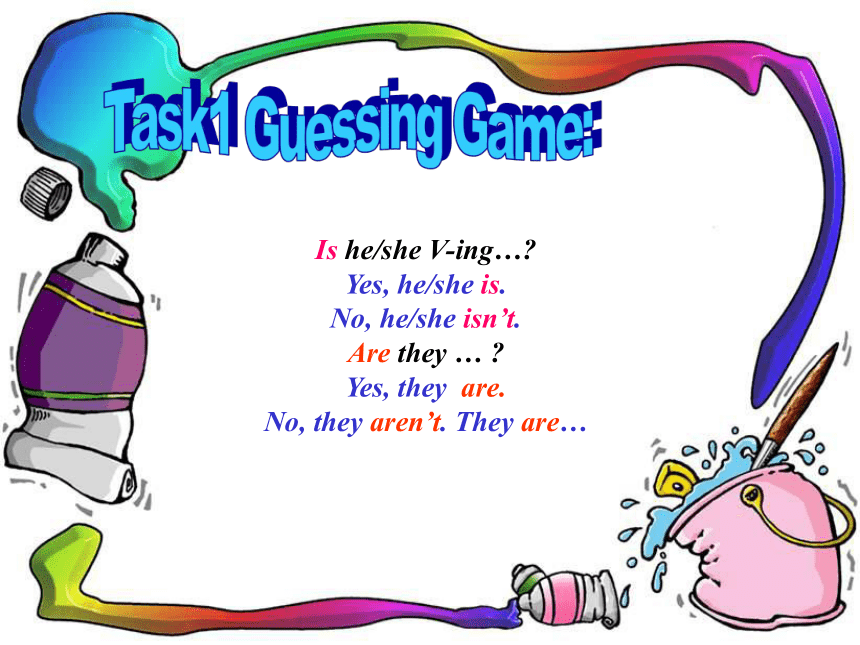
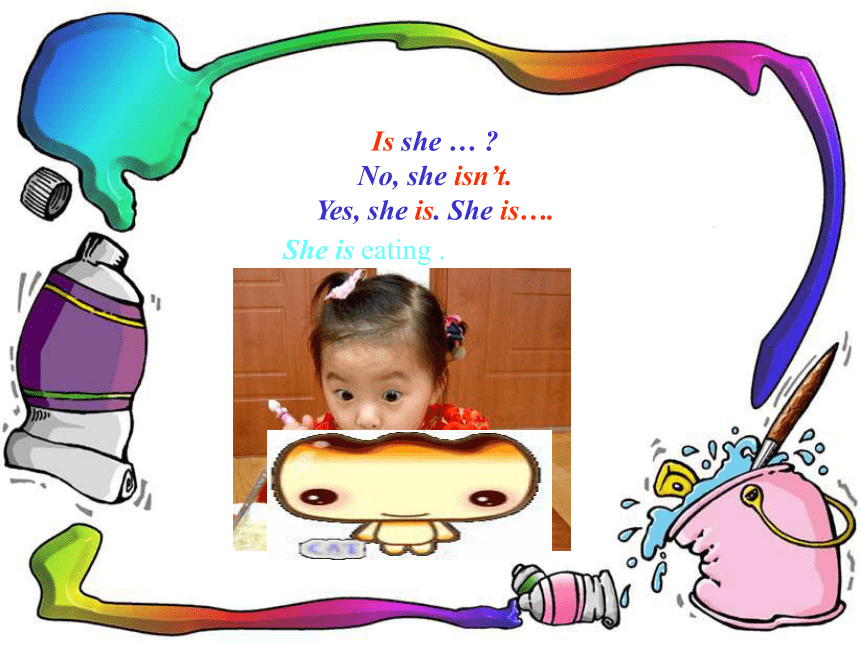
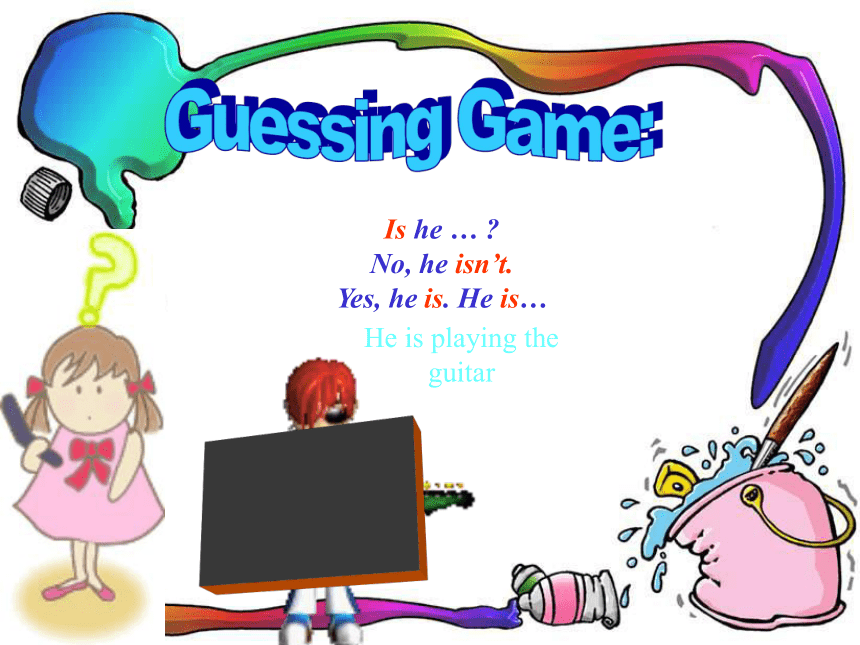
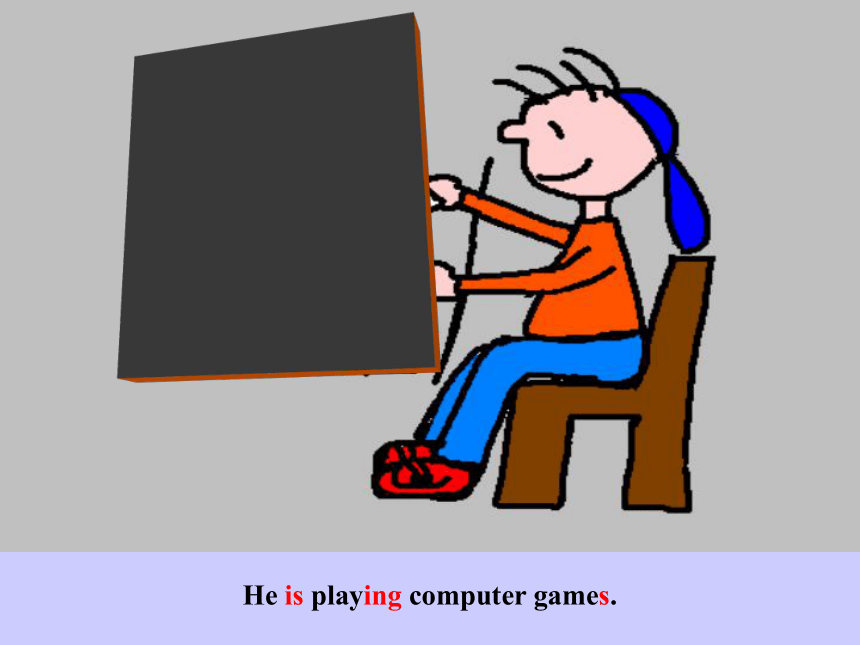
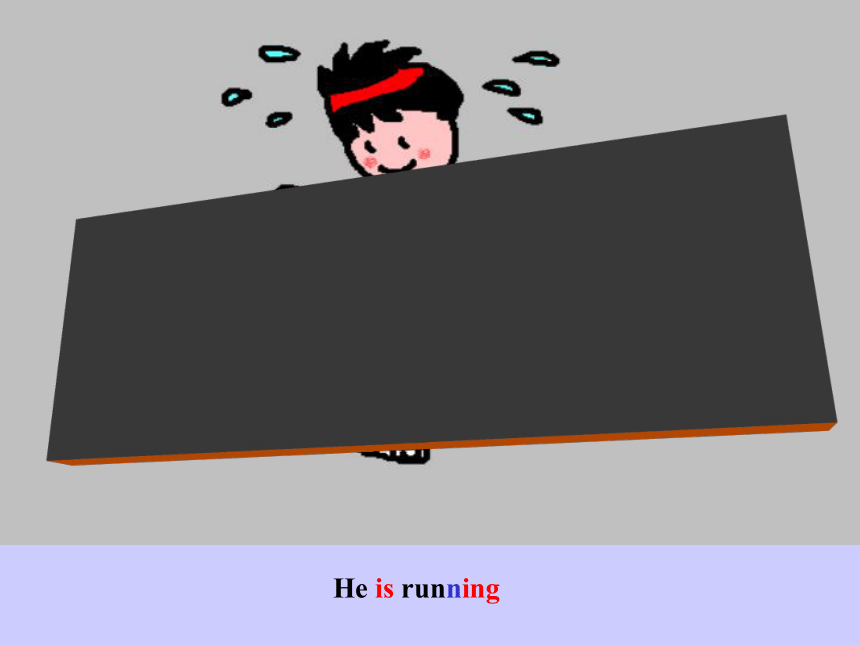
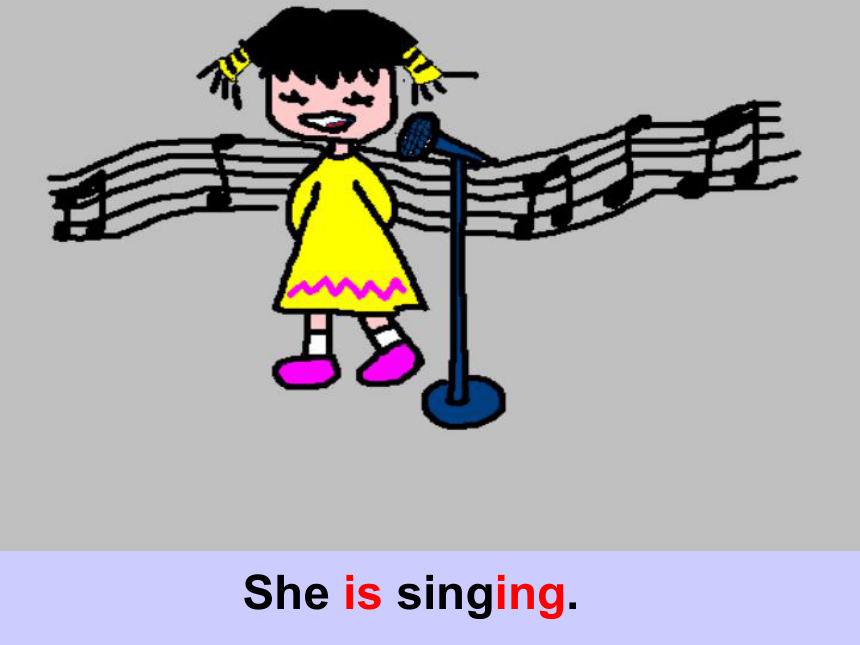
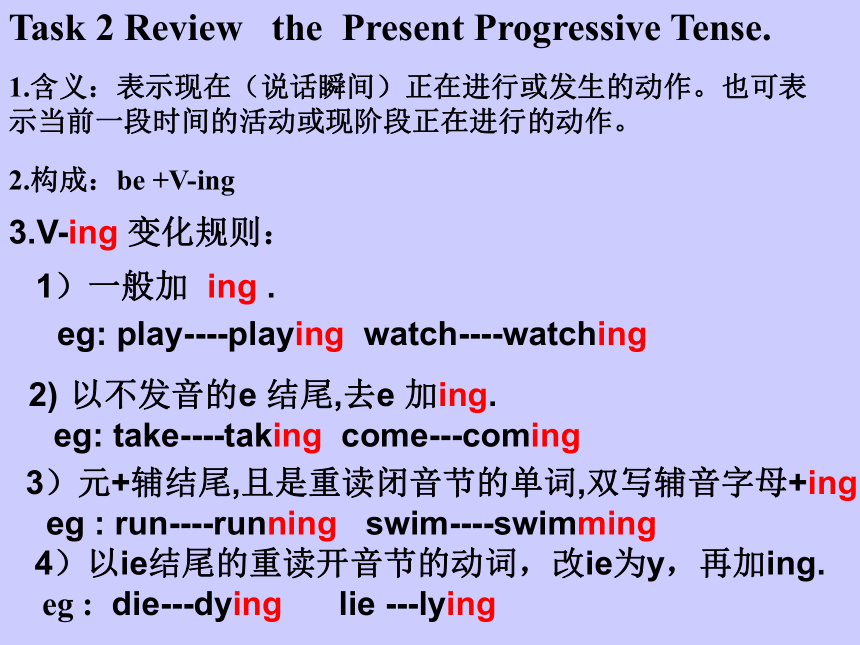
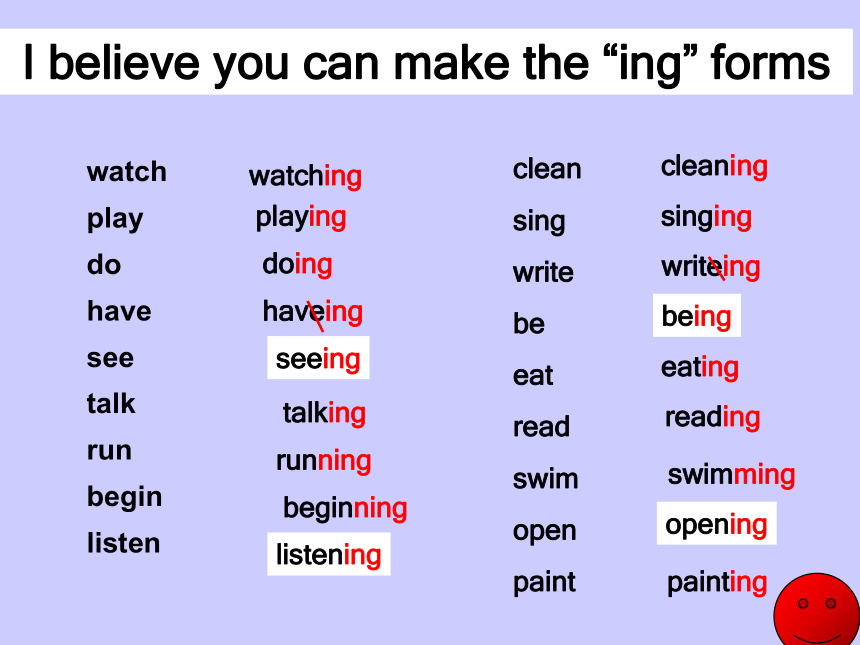
文档简介
课件25张PPT。Unit5 I'm watchingTV.By YuHuiSection BTask1 Guessing Game:Is he/she V-ing…?
Yes, he/she is.
No, he/she isn’t.
Are they … ?
Yes, they are.
No, they aren’t. They are…Is she … ?
No, she isn’t.
Yes, she is. She is…. She is eating .Guessing Game:Is he … ?
No, he isn’t.
Yes, he is. He is…He is playing the guitar
He is playing computer games.He is running
She is singing.1.含义:表示现在(说话瞬间)正在进行或发生的动作。也可表示当前一段时间的活动或现阶段正在进行的动作。
2.构成:be +V-ing Task 2 Review the Present Progressive Tense.3.V-ing 变化规则:
eg: play----playing watch----watching
以不发音的e 结尾,去e 加ing. 1)一般加 ing .eg: take----taking come---coming 3)元+辅结尾,且是重读闭音节的单词,双写辅音字母+ing. eg : run----running swim----swimming
4)以ie结尾的重读开音节的动词,改ie为y,再加ing.
eg : die---dying lie ---lying
clean
sing
write
be
eat
read
swim
open
paintwatchingplayingdoinghaveingtalkingrunningbeginninglisteningseeingsingingcleaningwriteingeatingreadingswimmingopeningpaintingbeingI believe you can make the “ing” forms watch
play
do
have
see
talk
run
begin
listen2.否定句:直接在be后加not.
如:I am writing.
I am not writing.现在进行时的句式1.肯定句: 主语+be +v-ing+其它.
如: I am reading a book.3. .一般疑问句及回答:问句,直接把be提前,其他照写.
肯定回答:Yes, 主语 +be.
否定回答: No, 主语 + be+ not
Task3 Exercise:Look! That girl __ ____ (ride) the bike.
Tom and I ___ ________(clean) our bedroom now.
The baby is sleeping and his mother _____
_______ _____(look after) him.
5. Listen! The twins ___ _______(sing) under the tree.
6.She’s opening the box now.(一般疑问句)
7. 1.I am watering the flowers.(否定句)
8.The boys are playing cards.(划线提问)
is ridingare cleaningis looking afterare singingIs she opening the box now?
I am not watering the flowers.
What are the boys doing?
Task 4 Look at the pictures. Complete the chart.libraryswimmingschoolPlaying basketballmallshopping
Where are they eating dinner? They are eating dinner in a restaurant.Task5 Look at the pictures .Then ask and answer questionsWhere is she swimming?She is swimming at the swimming pool. Where are they watching TV?They are watching TV at home. Where is he shopping? He is shopping in the supermarket. Where is she cleaning? She is cleaning in the classroom.Task6 Listen and write the places you hear in the chart.(2a)schoollibraryeating lunchPlaying basketballreading books3aDear Linda,
Thanks for your letter and the photos. Here are some of my photos. In the first photo, I’m playing basketball at school. In the second photo, I’m swimming at the pool. In the next photo, You can see my family at home. We’re eating dinner. In the last photo, I’m with my sister Gina. She’s doing her homework.---I’m watching TV.Goals:1. Thanks for
Thank you for
因为……而感谢
2.Here+be+n/n短语的结构
此结构实为一倒装结构意为这有……但其后若接代词的话则应为Here…..is.
Eg : Here you are.
Here it is.
3. some of +复数名词/短语
意为:…..中的一些.
Goals:4.family 为集合名词,含义为家庭,子女 ,在句中做主语时谓语动词的单复数要视情况而定。被看做整体时,用单数;若强调组织的多个成员时用复数。
eg: My family is moving to Beijing.
My family are eating dinner now.
4.at home 在家
5.In the first/second/…./next/last photo.
意为:在第….张照片中
6.be with sb = stay with sb 和某人在一起
Task 7 Do exercise.
1.Thank you for _______ (help) me with my English
2.Thanks for _____ (give) me so much help.
3.______ for your books and pens.
A. Thank B. Thanks C. Thank you D.B and C
4.Here are __ __ ___ ___. (我的一些杂志)
5.H_____ is a letter for you.
6.____the ___ _____(在第二张照片中)I’m watching TV
7.In the _____(three) photo. I’m with my brother.
8.Saturday is the l————day of a week.
9.Look, My brother is swimming at the p_______.
10.这是一张我家的照片.
This is a ____ ____ my family.
11.helpingB some of my magazinesereIn Second photothirdastoolPhoto ofgivingMy family is ___ (move) to Beijing.movingThank you!开音节与闭音节 1.以元音字母结尾或以辅音字母(r除外)加不发音的元音字母e结尾的音节,叫做开音节,在这种音节中的元音字母可读出字母的名称音。 例: no/noo/ type/taip/ me/mi:/ 2.以辅音字母(r除外)结尾的音节,叫闭音节,在这种音节中的元音字母则读与之相对应的音。 例:lesson/lesn/ big/big/ 即:闭音节和开音节的说法只与五个元音字母有关. 五个元音字母是 A E I O U 这五个元音字母本来的发音分别是Aa〔ei〕Ee〔i:〕Ii〔ai〕Oo〔?u〕Uu〔ju:〕 当它们在一个单词中读本来的音的时候,就叫开音节。 比如:name中的a字母,like 中的i字母 而这几个元音字母在单词中还可以发其他的音.列如〔?〕、〔e〕、〔i〕、〔?〕、〔?〕如:bag、cat、bed, desk、big、pig这时就叫做闭音节。 重读闭音节是指:这个动词是重读音节,同时单词的最后也是以辅音字母结尾的闭音节。 以辅音字母结尾,重读部分在后面的音节。 什么叫闭音节? 单个元音字母后面有辅字组成(r w y 除外),且以辅音字母结尾的重读音节。例如:bag draw begin fish not cup 英语重读闭音节就是所谓的元音字母不是发它本身的字母音,重读闭音节就是指在一个音节中,以辅音音素结尾的而且是重读音节的音节比如apple 划音节就应该是ap/ple 前面那个ap 是一个音节以辅音音素结尾就是闭音节。 重读闭音节三要素: 1. 必须是重读音节; 2. 最后只有一个辅音字母; 3.元音字母发短元音 重读闭音节就要双写.重读闭音节即两个辅音中间夹一个元音. 如:sit---sitting 举两个很经典的例子: forbid---forbidding (重读闭音节,双写) prohibit---prohibiting (重读在第二音节,非重读闭音节,不双写) 元音:a e i o u 辅音:b d g v r z n p m t c (k g) f l s h j x 重读闭音节法:两个辅音间夹着一个元音。 1.开音节分两种,绝对开音节和相对开音节 绝对开音节指的是 元音字母结尾 的音节 相对开音节是指 辅音字母-1元音字母-辅音字母-不发音e 的音节 ( re除外 ) 在开音节中, 元音字母发他们在字母表中的音 闭音节, 则是指 辅音字母-1元音字母-辅音字母 的音节 ( -al等除外) 在闭音节中,元音字母发不同的音 a e i o u 例 sat let sit not nut 2.英语重读闭音节就是所谓的元音字母不是发它本身的字母音,重读闭音节就是指在一个音节中,以辅音因素结尾的而且是重读音节的音节比如apple 划音节就因该是ap/ple 前面那个ap 是一个音节以辅音因素p结尾就是闭音节。 重读闭音节三要素: 1. 必须是重读音节; 2. 最后只有一个辅音字母; 3.元音字母发短元音 重读闭音节就要双写.重读闭音节即两个辅音中间夹一个元音. 如:sit---sitting begin---beginning(重读在gin这个音节上,相当与把gin该成双写的) 像travel这种重读不在的vel,可以为travelled,也可以是traveled. 开音节分两种,一种叫绝对开音节,相对开音节。 ①绝对开音节:单个元音字母后面没有辅字组的重读音节。例如:no blue ba-by stu-dent se-cret. ②相对开音节:单个元音字母后面加单个辅音字母,再加一个不发音字母e构成的重读音节。例如:name these bike home ex-cuse. 什么叫闭音节? 单个元音字母后面有辅字组(r w y 除外)且以辅字组结尾的重读音节。例如:bag egg fish not cup 重读音节指的是单词中读音特别响亮的音节。用音标标记双音节、多音节词的读音时,应使用重读符号。单音节词多数是重读音节,标记读音时不需要使用重读符号。 双音节词的第一个音节通常是重读音节。 例如:′stu-dent ′Chi-na ′sec-ond ′au-tumn in-′deed 含有a- be- de- re- in- ex- 等前缀的双音节词往往是在第二个音节上重读。双音节词的重读位置不会因增加前缀或后缀而发生改变。例如: a′bout be′fore ex′cuse re′pair for-′get-ful in-′ven-tor 多音节词通常在倒数第三个音节重读。 例如:′el-e-phant con-grat-u′la-tion 词尾有-ic或-tion,-sion的词,在-ic或-sion,-tion前的一个音节上重读。例如:scien′tific im′pression ′nation 词尾有-ic或-tion,-sion的词,在-ic或-sion,-tion前的一个音节上重读 ionic;republic;emphatic
34
Yes, he/she is.
No, he/she isn’t.
Are they … ?
Yes, they are.
No, they aren’t. They are…Is she … ?
No, she isn’t.
Yes, she is. She is…. She is eating .Guessing Game:Is he … ?
No, he isn’t.
Yes, he is. He is…He is playing the guitar
He is playing computer games.He is running
She is singing.1.含义:表示现在(说话瞬间)正在进行或发生的动作。也可表示当前一段时间的活动或现阶段正在进行的动作。
2.构成:be +V-ing Task 2 Review the Present Progressive Tense.3.V-ing 变化规则:
eg: play----playing watch----watching
以不发音的e 结尾,去e 加ing. 1)一般加 ing .eg: take----taking come---coming 3)元+辅结尾,且是重读闭音节的单词,双写辅音字母+ing. eg : run----running swim----swimming
4)以ie结尾的重读开音节的动词,改ie为y,再加ing.
eg : die---dying lie ---lying
clean
sing
write
be
eat
read
swim
open
paintwatchingplayingdoinghaveingtalkingrunningbeginninglisteningseeingsingingcleaningwriteingeatingreadingswimmingopeningpaintingbeingI believe you can make the “ing” forms watch
play
do
have
see
talk
run
begin
listen2.否定句:直接在be后加not.
如:I am writing.
I am not writing.现在进行时的句式1.肯定句: 主语+be +v-ing+其它.
如: I am reading a book.3. .一般疑问句及回答:问句,直接把be提前,其他照写.
肯定回答:Yes, 主语 +be.
否定回答: No, 主语 + be+ not
Task3 Exercise:Look! That girl __ ____ (ride) the bike.
Tom and I ___ ________(clean) our bedroom now.
The baby is sleeping and his mother _____
_______ _____(look after) him.
5. Listen! The twins ___ _______(sing) under the tree.
6.She’s opening the box now.(一般疑问句)
7. 1.I am watering the flowers.(否定句)
8.The boys are playing cards.(划线提问)
is ridingare cleaningis looking afterare singingIs she opening the box now?
I am not watering the flowers.
What are the boys doing?
Task 4 Look at the pictures. Complete the chart.libraryswimmingschoolPlaying basketballmallshopping
Where are they eating dinner? They are eating dinner in a restaurant.Task5 Look at the pictures .Then ask and answer questionsWhere is she swimming?She is swimming at the swimming pool. Where are they watching TV?They are watching TV at home. Where is he shopping? He is shopping in the supermarket. Where is she cleaning? She is cleaning in the classroom.Task6 Listen and write the places you hear in the chart.(2a)schoollibraryeating lunchPlaying basketballreading books3aDear Linda,
Thanks for your letter and the photos. Here are some of my photos. In the first photo, I’m playing basketball at school. In the second photo, I’m swimming at the pool. In the next photo, You can see my family at home. We’re eating dinner. In the last photo, I’m with my sister Gina. She’s doing her homework.---I’m watching TV.Goals:1. Thanks for
Thank you for
因为……而感谢
2.Here+be+n/n短语的结构
此结构实为一倒装结构意为这有……但其后若接代词的话则应为Here…..is.
Eg : Here you are.
Here it is.
3. some of +复数名词/短语
意为:…..中的一些.
Goals:4.family 为集合名词,含义为家庭,子女 ,在句中做主语时谓语动词的单复数要视情况而定。被看做整体时,用单数;若强调组织的多个成员时用复数。
eg: My family is moving to Beijing.
My family are eating dinner now.
4.at home 在家
5.In the first/second/…./next/last photo.
意为:在第….张照片中
6.be with sb = stay with sb 和某人在一起
Task 7 Do exercise.
1.Thank you for _______ (help) me with my English
2.Thanks for _____ (give) me so much help.
3.______ for your books and pens.
A. Thank B. Thanks C. Thank you D.B and C
4.Here are __ __ ___ ___. (我的一些杂志)
5.H_____ is a letter for you.
6.____the ___ _____(在第二张照片中)I’m watching TV
7.In the _____(three) photo. I’m with my brother.
8.Saturday is the l————day of a week.
9.Look, My brother is swimming at the p_______.
10.这是一张我家的照片.
This is a ____ ____ my family.
11.helpingB some of my magazinesereIn Second photothirdastoolPhoto ofgivingMy family is ___ (move) to Beijing.movingThank you!开音节与闭音节 1.以元音字母结尾或以辅音字母(r除外)加不发音的元音字母e结尾的音节,叫做开音节,在这种音节中的元音字母可读出字母的名称音。 例: no/noo/ type/taip/ me/mi:/ 2.以辅音字母(r除外)结尾的音节,叫闭音节,在这种音节中的元音字母则读与之相对应的音。 例:lesson/lesn/ big/big/ 即:闭音节和开音节的说法只与五个元音字母有关. 五个元音字母是 A E I O U 这五个元音字母本来的发音分别是Aa〔ei〕Ee〔i:〕Ii〔ai〕Oo〔?u〕Uu〔ju:〕 当它们在一个单词中读本来的音的时候,就叫开音节。 比如:name中的a字母,like 中的i字母 而这几个元音字母在单词中还可以发其他的音.列如〔?〕、〔e〕、〔i〕、〔?〕、〔?〕如:bag、cat、bed, desk、big、pig这时就叫做闭音节。 重读闭音节是指:这个动词是重读音节,同时单词的最后也是以辅音字母结尾的闭音节。 以辅音字母结尾,重读部分在后面的音节。 什么叫闭音节? 单个元音字母后面有辅字组成(r w y 除外),且以辅音字母结尾的重读音节。例如:bag draw begin fish not cup 英语重读闭音节就是所谓的元音字母不是发它本身的字母音,重读闭音节就是指在一个音节中,以辅音音素结尾的而且是重读音节的音节比如apple 划音节就应该是ap/ple 前面那个ap 是一个音节以辅音音素结尾就是闭音节。 重读闭音节三要素: 1. 必须是重读音节; 2. 最后只有一个辅音字母; 3.元音字母发短元音 重读闭音节就要双写.重读闭音节即两个辅音中间夹一个元音. 如:sit---sitting 举两个很经典的例子: forbid---forbidding (重读闭音节,双写) prohibit---prohibiting (重读在第二音节,非重读闭音节,不双写) 元音:a e i o u 辅音:b d g v r z n p m t c (k g) f l s h j x 重读闭音节法:两个辅音间夹着一个元音。 1.开音节分两种,绝对开音节和相对开音节 绝对开音节指的是 元音字母结尾 的音节 相对开音节是指 辅音字母-1元音字母-辅音字母-不发音e 的音节 ( re除外 ) 在开音节中, 元音字母发他们在字母表中的音 闭音节, 则是指 辅音字母-1元音字母-辅音字母 的音节 ( -al等除外) 在闭音节中,元音字母发不同的音 a e i o u 例 sat let sit not nut 2.英语重读闭音节就是所谓的元音字母不是发它本身的字母音,重读闭音节就是指在一个音节中,以辅音因素结尾的而且是重读音节的音节比如apple 划音节就因该是ap/ple 前面那个ap 是一个音节以辅音因素p结尾就是闭音节。 重读闭音节三要素: 1. 必须是重读音节; 2. 最后只有一个辅音字母; 3.元音字母发短元音 重读闭音节就要双写.重读闭音节即两个辅音中间夹一个元音. 如:sit---sitting begin---beginning(重读在gin这个音节上,相当与把gin该成双写的) 像travel这种重读不在的vel,可以为travelled,也可以是traveled. 开音节分两种,一种叫绝对开音节,相对开音节。 ①绝对开音节:单个元音字母后面没有辅字组的重读音节。例如:no blue ba-by stu-dent se-cret. ②相对开音节:单个元音字母后面加单个辅音字母,再加一个不发音字母e构成的重读音节。例如:name these bike home ex-cuse. 什么叫闭音节? 单个元音字母后面有辅字组(r w y 除外)且以辅字组结尾的重读音节。例如:bag egg fish not cup 重读音节指的是单词中读音特别响亮的音节。用音标标记双音节、多音节词的读音时,应使用重读符号。单音节词多数是重读音节,标记读音时不需要使用重读符号。 双音节词的第一个音节通常是重读音节。 例如:′stu-dent ′Chi-na ′sec-ond ′au-tumn in-′deed 含有a- be- de- re- in- ex- 等前缀的双音节词往往是在第二个音节上重读。双音节词的重读位置不会因增加前缀或后缀而发生改变。例如: a′bout be′fore ex′cuse re′pair for-′get-ful in-′ven-tor 多音节词通常在倒数第三个音节重读。 例如:′el-e-phant con-grat-u′la-tion 词尾有-ic或-tion,-sion的词,在-ic或-sion,-tion前的一个音节上重读。例如:scien′tific im′pression ′nation 词尾有-ic或-tion,-sion的词,在-ic或-sion,-tion前的一个音节上重读 ionic;republic;emphatic
34
同课章节目录
- Unit 1 Can you play the guitar?
- Section A
- Section B
- Unit 2 What time do you go to school?
- Section A
- Section B
- Unit 3 How do you get to school?
- Section A
- Section B
- Unit 4 Don't eat in class.
- Section A
- Section B
- Unit 5 Why do you like pandas?
- Section A
- Section B
- Unit 6 I'm watching TV.
- Section A
- Section B
- Review of Units 1-6
- Unit 7 It's raining!
- Section A
- Section B
- Unit 8 Is there a post office near here?
- Section A
- Section B
- Unit 9 What does he look like?
- Section A
- Section B
- Unit 10 I'd like some noodles.
- Section A
- Section B
- Unit 11 How was your school trip?
- Section A
- Section B
- Unit 12 What did you do last weekend?
- Section A
- Section B
